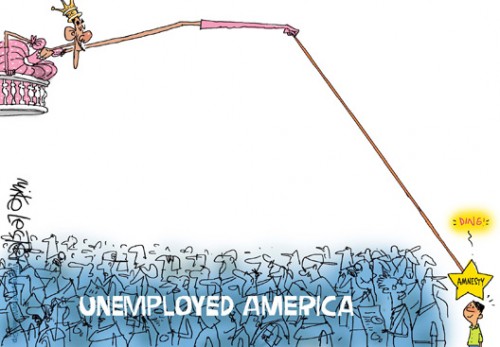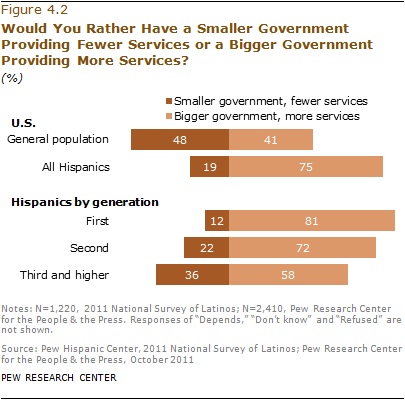Establishment Republicans Fret about Hispanic Opinion, while White Working Class Voters Are Available
12/30/2014
Senator Lindsey Graham is a regular perpetual motion machine for amnesty. He typifies the Republican Inc. view that maximum outreach is required for hispanic votes, and that includes mega-amnesty aka work permits for millions of foreign lawbreakers to compete with citizens for scarce jobs. 
Grahams establishment views make him a popular guest for the mainstream liberal media, and his Sunday CNN appearance inspired a follow-up by National Journal:
Graham: GOP must tackle immigration to win White House, The Hill, December 28, 2014
Sen. Lindsey Graham (R-S.C.) is warning the Republican Party that its chances of winning the White House in 2016 will be almost nonexistent if it does not at least take a step toward immigration reform.
Graham, who has floated a presidential run himself, was a supporter of the immigration reform bill that passed the Senate last year.
If we dont at least make a down payment on solving the problem and rationally dealing with the 11 million [people in the country illegally], if we become the party of self-deportation in 2015 and 2016, then the chance of winning the White House I think is almost nonexistent, Graham said on CNNs State of the Union in an interview posted Sunday …
Would it be too much to ask our political leaders to occasionally consider in drafting legislation the basics of human psychology, particularly that rewarding a behavior encourages more of same? Also decreasing an unwanted behavior requires punishment or at least negative reinforcement of some sort.
Meanwhile, and less noticed, is how Democrats are similarly fretting about their loss of white working class voters. Republicans are worrying about the opinion of hispanics who may or may not be legal residents while Democrats have lost actual Americans, working people who were once the backbone of the Democrat party.

Perhaps Republicans should pay more attention to blue-collar working people who have been crushed by industry outsourcing employment and excessive immigration to fill jobs that cannot be sent abroad. It also should count for something that traditional Americans tend to prefer more freedom and less government, while hispanics as a culture favor big government, as shown in the accompanying Pew graph.
Charlie Cook described the Democrats loss of white voters earlier this month:
Democrats Paved the Way for Their Own Decline, National Journal, December 1, 2014
They have subordinated their traditional focus on helping working-class Americans move up the economic ladder in favor of other priorities.
Much has been said about the long-term demographic challenges facing the Republican Party. Given how dismally Republicans fare with African-American voters — Mitt Romney and congressional Republicans garnered only 6 percent and 8 percent, respectively, in 2012, and this year congressional Republicans got 10 percent — it matters how the GOP does with other minority voters.
In 2012, Romney picked up 27 percent and congressional Republicans received 30 percent of the Latino vote. This year, House Republicans got 36 percent. This doesnt matter that much in the House, because of natural residential patterns and, to a lesser extent, gerrymandering. But it is a big deal in presidential matters and in some Senate election years more than others (the Latino vote will be much more critical in the 2016 class of Senate seats than it was in the 2014 grouping).
But considerably less is being said about a parallel problem that Democrats are facing. Although the national red-blue maps of the partisan makeup of the House, the governorships, and, somewhat less so, the Senate are misleading in that they equate population with land area, the maps do illustrate where Democrats are strong and where they are not (interesting factoid: Only 14 percent of the land area in the U.S. is represented by a Democrat in the House). Increasingly, Democratic strength is concentrated primarily in urban areas and college towns, among minorities, and in narrow bands along the West Coast (but only the first 50-100 miles from the beaches) and the East Coast (but only from New York City northward). The South and the Border South, as well as small-town and rural America, are rapidly becoming no-fly zones for Democrats. Few Democrats represent small-town and rural areas, and the party is find it increasingly difficult to attract noncollege-educated white voters.
This challenge for Democrats can be sliced and diced a number of ways: by race, by where people live, and — very acutely — by combining race with socioeconomic status. A Nov. 25 report by the Gallup Organization underscored Democrats problems with noncollege-educated white voters. According to Gallup Editor Frank Newport, President Barack Obamas job-approval rating among white noncollege graduates is at 27 percent so far in 2014, 14 percentage points lower than among white college graduates. This is the largest yearly gap between these two groups since Obama took office. These data underscore the magnitude of the Democratic Partys problem with working-class whites, among whom Obama lost in the 2012 presidential election, and among whom Democratic House candidates lost in the 2014 U.S. House voting by 30 points.
There are many reasons for this decline in support for Democrats among certain groups. But an argument can be made that it is because Democrats have subordinated their traditional focus on helping lower- and working-class Americans move up the economic ladder in favor of other noble priorities, such as health care, the environment, and civil rights. Whether these were the right or wrong priorities is totally subjective, but they have come at a cost. Sen. Chuck Schumer recently committed the classic case of a political gaffe, once defined by Michael Kinsley as when a politician tells the truth — some obvious truth he isnt supposed to say. The Democratic Left went crazy when Schumer suggested that the early focus on health care reform in 2009 and 2010, when he says Democrats should have been concentrating on economic growth and job creation, had cost them greatly (something that I have written about for over five years).
Governing is about making choices and facing consequences. Implicitly, to focus on certain things is to de-emphasize other things. The modern Democratic Party was effectively born during President Franklin Roosevelts New Deal, reacting and dealing with the Great Depression. While books have been filled with the multitude of things that Roosevelt and his New Dealers did, if you boiled it down to its essence, it was helping people get back on their feet after the great stock-market crash of 1929 and the deep depression that resulted. In 2008, we faced the Great Recession, and like other financial meltdowns, it was deep and painful. At the tail end of the George W. Bush administration and in the early Obama years, financial markets were stabilized (the overwhelming majority of the Troubled Asset Relief Program funds have been repaid, with many of the investments yielding profits for Uncle Sam), and the Obama administration should be applauded for rescuing the automobile industry. But while those actions can be legitimately seen as a good start, we then saw a grand pivot to the environment and health care, with grave consequences for the party. At another time and in different fashion, both are important priorities, but the focus on these issues has effectively decimated the Democratic Party in specific areas and among specific voter blocs. The evidence is the difference in the partisan makeup of the Congress that will be sworn in next month, compared with the one from eight years ago.
